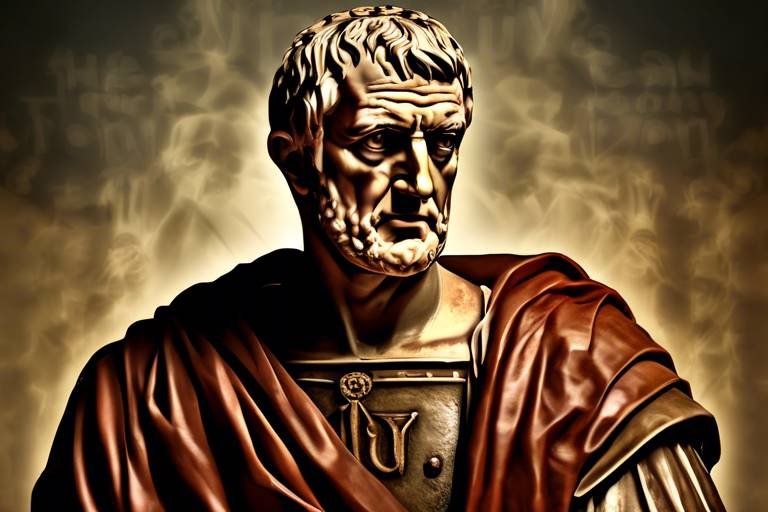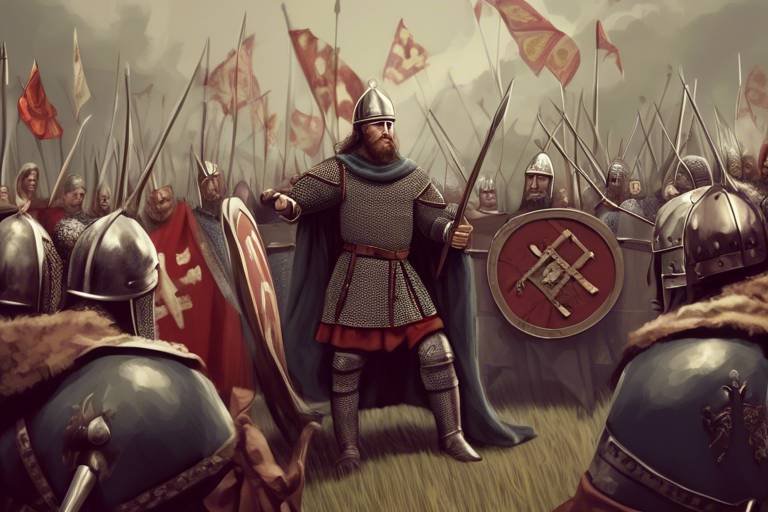Apollonius: The Geometer of Conics
Apollonius of Perga, widely recognized as the Great Geometer, stands as a prominent figure in ancient Greek mathematics for his remarkable contributions to the study of conic sections. His work not only revolutionized geometry but also served as the cornerstone for future mathematicians to build upon.
Apollonius' early life and education played a crucial role in shaping his mathematical genius. Growing up in ancient Greece, he was influenced by the rich educational environment of the time, which nurtured his innate talent and passion for mathematics.
Conic sections, a significant area of study in mathematics, encompass three fundamental shapes: the ellipse, parabola, and hyperbola. These geometric figures, as explored by Apollonius, hold immense importance in various mathematical applications.
The ellipse, one of the conic sections, exhibits unique properties that distinguish it from other shapes. Its equations and characteristics find practical applications in fields ranging from astronomy to architecture, showcasing its versatility and significance.
On the other hand, the parabola, with its distinct properties and real-world examples, demonstrates a symmetrical curve that has fascinated mathematicians and scientists alike. Understanding its equations and behavior provides valuable insights into natural phenomena.
Delving into the hyperbola, another conic section, reveals a shape characterized by two separate curves that extend infinitely. Its mathematical representations and practical uses in geometry and physics highlight the complexity and elegance of this geometric figure.
Apollonius' seminal work on conic sections, particularly his treatise "Conics," remains a cornerstone in the field of mathematics. His groundbreaking contributions have left an indelible mark on the study of geometry, inspiring generations of mathematicians to explore the intricate world of conic shapes.
The enduring legacy of Apollonius continues to influence modern mathematicians and scholars, underscoring the timeless relevance of his geometric insights. His innovative approach to conic sections has paved the way for further advancements in mathematics and geometry.
In contemporary times, conic sections find diverse applications in technology, engineering, astronomy, and various scientific disciplines. From designing satellite orbits to analyzing architectural structures, the practical utility of conic shapes underscores their continued relevance in the modern world.

Great Geometer
Apollonius of Perga was an ancient Greek mathematician known as the for his work on conic sections. His contributions revolutionized the study of geometry and laid the foundation for later mathematicians.
Exploring Apollonius' background, upbringing, and the educational influences that shaped his mathematical prowess in ancient Greece.
An introduction to conic sections, including the definitions of the ellipse, parabola, and hyperbola, and their significance in mathematics.
Detailed examination of the ellipse, its properties, equations, and applications in various fields of study.
Understanding the parabola's unique characteristics, equations, and real-world examples of its occurrence.
Insightful analysis of the hyperbola, its mathematical representations, and practical uses in geometry and physics.
An overview of Apollonius' major works on conic sections, including his groundbreaking treatise Conics and its impact on mathematics.
Exploring the lasting legacy of Apollonius' geometric contributions and his influence on future mathematicians and scholars.
Highlighting contemporary applications of conic sections in technology, engineering, astronomy, and other scientific disciplines.

for his work on conic sections. His contributions revolutionized the study of geometry and laid the foundation for later mathematicians.
Apollonius of Perga was an ancient Greek mathematician known as the Great Geometer for his work on conic sections. His contributions revolutionized the study of geometry and laid the foundation for later mathematicians.
Exploring Apollonius' background, upbringing, and the educational influences that shaped his mathematical prowess in ancient Greece.
An introduction to conic sections, including the definitions of the ellipse, parabola, and hyperbola, and their significance in mathematics.
Detailed examination of the ellipse, its properties, equations, and applications in various fields of study.
Understanding the parabola's unique characteristics, equations, and real-world examples of its occurrence.
Insightful analysis of the hyperbola, its mathematical representations, and practical uses in geometry and physics.
An overview of Apollonius' major works on conic sections, including his groundbreaking treatise Conics and its impact on mathematics.
Exploring the lasting legacy of Apollonius' geometric contributions and his influence on future mathematicians and scholars.
Highlighting contemporary applications of conic sections in technology, engineering, astronomy, and other scientific disciplines.

Early Life and Education
Apollonius of Perga was an ancient Greek mathematician known as the Great Geometer for his work on conic sections. His contributions revolutionized the study of geometry and laid the foundation for later mathematicians.
Apollonius of Perga's early life and education played a crucial role in shaping his mathematical genius. Born in the ancient city of Perga, located in present-day Turkey, Apollonius was influenced by the rich intellectual environment of the time. His education began in his hometown, where he showed exceptional talent in mathematics from a young age. Apollonius later traveled to Alexandria, the center of learning in the ancient world, to further his studies under the guidance of renowned scholars.
During his time in Alexandria, Apollonius immersed himself in the study of mathematics, astronomy, and philosophy, honing his skills and expanding his knowledge. The diverse influences of the scholars he encountered during his travels contributed to the development of his unique geometric insights.
Apollonius' education was not just about acquiring knowledge but also about fostering a deep understanding of the fundamental principles of mathematics. His dedication to learning and exploration set the stage for his future groundbreaking work in the field of geometry.
An introduction to conic sections reveals the beauty and complexity of these geometric shapes. The ellipse, parabola, and hyperbola are fundamental curves that arise from the intersection of a plane with a cone. Each conic section has distinct properties and applications that have fascinated mathematicians for centuries.
The ellipse, with its symmetric shape and mathematical elegance, has captured the imagination of mathematicians and scientists alike. Its properties, such as the sum of distances from any point on the curve to two fixed points (foci), make it a key element in various branches of mathematics and physics.
The parabola, known for its reflective properties and simple equation, has practical applications in optics, engineering, and physics. Its unique shape allows for the focusing of light and the design of structures that harness its geometric properties.
The hyperbola, with its two separate curves that never meet, presents intriguing mathematical challenges and practical applications. From celestial mechanics to satellite trajectories, the hyperbola plays a vital role in understanding the dynamics of objects in motion.
Apollonius' most famous work, Conics, is a masterpiece that delves deep into the study of conic sections. In this treatise, he presents groundbreaking theorems and geometric constructions that have stood the test of time. His meticulous approach to geometry and his innovative methods have inspired generations of mathematicians.
Apollonius' legacy extends far beyond his own time, influencing mathematicians and scholars throughout history. His geometric insights and contributions to the study of conic sections have paved the way for advancements in mathematics and science. Apollonius' work continues to be studied and admired for its intellectual depth and mathematical brilliance.
In the modern world, conic sections find applications in various fields ranging from technology to astronomy. Engineers use conic shapes in the design of structures and machinery, while astronomers apply conic sections to model the orbits of celestial bodies. The enduring relevance of conic sections highlights their importance in contemporary scientific disciplines.

Conic Sections Overview
Apollonius of Perga was an ancient Greek mathematician known as the Great Geometer for his work on conic sections. His contributions revolutionized the study of geometry and laid the foundation for later mathematicians.
Conic sections are fundamental geometric shapes that arise from the intersection of a plane and a cone. These shapes include the ellipse, parabola, and hyperbola, each with unique properties and applications in mathematics.
Conic sections have played a crucial role in various fields, from astronomy to engineering, providing insights into the behavior of curves and their mathematical representations.
Understanding conic sections allows mathematicians and scientists to model real-world phenomena, predict trajectories, and solve complex problems with precision.
Apollonius' work on conic sections significantly advanced the study of these shapes, paving the way for further exploration and application in diverse disciplines.
By delving into the intricacies of conic sections, one can appreciate the elegance and mathematical beauty that underlie these geometric constructs, showcasing the interconnectedness of geometry and algebra in shaping our understanding of the world.

Ellipse Exploration
When delving into the fascinating world of conic sections, the exploration of ellipses unveils a realm of mathematical beauty and practical applications. An ellipse, often described as a stretched circle, holds unique properties that captivate mathematicians and scientists alike.
Defined as the set of points where the sum of the distances from two fixed points (foci) is constant, the ellipse showcases symmetry and elegance in its mathematical representation. With equations that depict its elongated shape and focus points, the ellipse finds its way into various fields of study, from astronomy to architectural design.
One intriguing aspect of ellipses is their prevalence in nature, with celestial bodies like planets and moons tracing elliptical orbits around their gravitational centers. This natural occurrence of ellipses reinforces their significance in understanding the dynamics of the universe.
Moreover, the practical applications of ellipses extend beyond theoretical mathematics, finding utility in engineering designs, such as satellite orbits and antenna reflectors. The precise geometric properties of ellipses enable engineers to optimize performance and efficiency in technological systems.
As we unravel the mysteries of ellipses through Apollonius' geometric insights, we appreciate the intricate balance between mathematical theory and real-world applications. The exploration of ellipses not only enriches our understanding of geometry but also highlights the interconnectedness of mathematics with the physical world.

Parabola Properties
Apollonius of Perga was an ancient Greek mathematician known as the Great Geometer for his work on conic sections. His contributions revolutionized the study of geometry and laid the foundation for later mathematicians.
Exploring Apollonius' background, upbringing, and the educational influences that shaped his mathematical prowess in ancient Greece.
An introduction to conic sections, including the definitions of the ellipse, parabola, and hyperbola, and their significance in mathematics.
Detailed examination of the ellipse, its properties, equations, and applications in various fields of study.
When it comes to the parabola, it's like a mathematical superhero with its unique characteristics and equations. Just like a superhero has its signature moves, the parabola has its defining properties that set it apart from other conic sections. From its symmetrical shape to its focus-directrix property, the parabola is a versatile curve that appears in nature, architecture, and even satellite dishes. Its reflective property makes it a key player in optics, focusing light and sound waves to specific points. Understanding the parabola's properties opens up a world of applications in physics, engineering, and even art.
Insightful analysis of the hyperbola, its mathematical representations, and practical uses in geometry and physics.
An overview of Apollonius' major works on conic sections, including his groundbreaking treatise Conics and its impact on mathematics.
Exploring the lasting legacy of Apollonius' geometric contributions and his influence on future mathematicians and scholars.
Highlighting contemporary applications of conic sections in technology, engineering, astronomy, and other scientific disciplines.

Hyperbola Insights
When delving into the realm of conic sections, the hyperbola emerges as a fascinating geometric shape that captivates mathematicians and physicists alike. Defined as the set of all points where the absolute difference of the distances from two fixed points, known as the foci, is constant, the hyperbola possesses unique properties that set it apart from its conic counterparts.
One of the defining characteristics of a hyperbola is its two distinct branches that curve away from each other, resembling two mirrored parabolas. These branches extend infinitely, never meeting or intersecting, creating an open curve that symbolizes boundless possibilities and diverging paths in the mathematical landscape.
Mathematically, the hyperbola can be represented by the equation x^2/a^2 - y^2/b^2 1 or y^2/b^2 - x^2/a^2 1, where 'a' and 'b' are constants determining the shape and orientation of the hyperbola. This algebraic expression encapsulates the essence of the hyperbola's geometric properties and aids in its exploration across various mathematical contexts.
Moreover, the hyperbola finds practical applications in fields such as optics, where it plays a crucial role in the design of satellite dishes and antennas to reflect and focus electromagnetic signals. By leveraging the unique reflective properties of the hyperbola, engineers and scientists can optimize signal reception and transmission, enhancing communication systems and technological advancements.
As we unravel the intricacies of the hyperbola, we uncover a world of mathematical elegance and practical utility that reverberates through centuries of geometric exploration. From ancient mathematicians like Apollonius to modern-day innovators pushing the boundaries of science, the hyperbola stands as a testament to the enduring allure and versatility of conic sections in shaping our understanding of the mathematical universe.

Apollonius' Conic Works
Apollonius of Perga, also known as the Great Geometer, left an indelible mark on the world of mathematics with his profound contributions to conic sections. One of his most renowned works is the treatise Conics, a comprehensive study that delves into the properties and equations of ellipses, parabolas, and hyperbolas. Through meticulous exploration and analysis, Apollonius laid the groundwork for understanding these geometric shapes and their significance in mathematical theory.
In Conics, Apollonius meticulously detailed the relationships and properties of conic sections, providing geometric insights that were unparalleled in his time. His work not only expanded the boundaries of mathematical knowledge but also set a standard for precision and rigor in geometric analysis. By examining the intricate curves of ellipses, parabolas, and hyperbolas, Apollonius unlocked a world of mathematical possibilities that continue to inspire scholars and mathematicians to this day.
One of the key contributions of Apollonius' Conics is the classification and study of the different types of conic sections. By defining the parameters and equations that govern ellipses, parabolas, and hyperbolas, Apollonius provided a framework for understanding the geometric properties of these curves. His systematic approach to conic sections laid the foundation for future mathematical developments, shaping the course of geometry and algebra for centuries to come.
Through his meticulous attention to detail and innovative mathematical techniques, Apollonius established himself as a pioneer in the field of conic sections. His work not only advanced the study of geometry but also paved the way for new discoveries and applications in mathematics. The legacy of Apollonius' conic works continues to resonate in the world of mathematics, serving as a testament to his enduring influence and intellectual prowess.

Conics
Conics are a fundamental aspect of geometry that Apollonius of Perga extensively studied and contributed to. These geometric figures, including the ellipse, parabola, and hyperbola, play a crucial role in various mathematical applications and real-world scenarios. Understanding conic sections provides insights into the relationships between shapes and equations, offering a deeper comprehension of geometric principles.
When examining conic sections, each shape possesses unique characteristics that distinguish it from the others. The ellipse, for instance, represents a closed curve where the sum of the distances from two fixed points (foci) to any point on the curve remains constant. In contrast, the parabola is a symmetric curve where all points are equidistant from a fixed point (focus) and a line (directrix). The hyperbola, on the other hand, consists of two separate curves that mirror each other, with the difference of distances from two fixed points (foci) being constant.
Apollonius' work on conics delved deep into the properties and equations of these geometric shapes, laying the groundwork for future advancements in mathematics. His treatise "Conics" remains a cornerstone in the study of geometry, showcasing his meticulous analysis and innovative approaches to conic sections. By exploring the intricacies of conics, mathematicians can unravel complex relationships and patterns that underpin geometric constructions and calculations.
Moreover, the applications of conic sections extend beyond theoretical mathematics, finding practical utility in various fields such as architecture, physics, astronomy, and engineering. The ability to model and manipulate conic shapes enables scientists and engineers to design structures, analyze trajectories, and predict celestial movements with precision. From satellite orbits to architectural designs, conics offer a versatile toolkit for solving real-world problems and optimizing solutions.
As we navigate the realm of conics, we uncover a rich tapestry of mathematical concepts intertwined with practical applications. The legacy of Apollonius as the Great Geometer resonates through the centuries, inspiring generations of mathematicians to explore the beauty and complexity of conic sections. By embracing the elegance of these geometric figures, we embark on a journey of discovery and innovation, unlocking the secrets of the universe through the lens of conics.

and its impact on mathematics.
Apollonius' work on conic sections, particularly his treatise Conics, had a profound impact on the field of mathematics. His systematic approach to studying the properties of conic curves and their geometric relationships laid the groundwork for future mathematicians to expand upon his theories. Apollonius' meticulous analysis of ellipses, parabolas, and hyperbolas not only deepened the understanding of these shapes but also provided a framework for solving complex mathematical problems.

Legacy and Influence
Apollonius of Perga's legacy as the Great Geometer continues to influence the field of mathematics and beyond to this day. His groundbreaking work on conic sections, particularly in his treatise Conics, has left an indelible mark on the study of geometry and mathematics as a whole. Apollonius' meticulous exploration of ellipses, parabolas, and hyperbolas paved the way for future mathematicians to delve deeper into these geometric shapes and their properties.
One of the most significant aspects of Apollonius' influence is his methodical approach to mathematics. He not only defined the conic sections but also developed a systematic way of studying them, which laid the foundation for modern analytical geometry. His emphasis on precision and rigor in mathematical proofs set a standard for generations of mathematicians to come.
Furthermore, Apollonius' work inspired many prominent mathematicians throughout history, including Descartes and Newton, who built upon his ideas to make further advancements in geometry and calculus. His influence can be seen in various branches of mathematics, physics, and engineering, where conic sections are applied to solve real-world problems and model natural phenomena.
Moreover, Apollonius' legacy extends beyond the realm of mathematics. His dedication to the pursuit of knowledge and his innovative thinking serve as a testament to the power of intellectual curiosity and perseverance. By challenging the conventional wisdom of his time and pushing the boundaries of mathematical understanding, Apollonius set a precedent for future scholars to question, explore, and innovate.
In conclusion, Apollonius of Perga's legacy and influence are profound and enduring. His contributions to the study of conic sections and geometry have shaped the way we understand the world around us and continue to inspire generations of mathematicians and thinkers. As we marvel at the beauty and complexity of conic shapes, we owe a debt of gratitude to Apollonius, the visionary geometer who unlocked their secrets and left an everlasting impact on the history of mathematics.

Modern Applications of Conics
Modern Applications of Conics showcase the enduring relevance of Apollonius' geometric discoveries in contemporary society. From engineering marvels to astronomical revelations, conic sections continue to shape various scientific disciplines with their practical utility and elegance.
In the field of technology, conic sections find application in designing satellite dishes and antennas, where parabolic shapes are utilized to focus signals efficiently. The precision of conic curves plays a crucial role in optimizing communication systems and ensuring seamless connectivity.
Moreover, engineering marvels such as bridges and arches benefit from the mathematical principles of conics. The structural stability and aesthetic appeal of these architectural wonders owe much to the intricate calculations based on conic sections, ensuring both form and function are harmoniously balanced.
Conic sections also play a pivotal role in astronomy, aiding scientists in modeling planetary orbits and predicting celestial phenomena. The elliptical paths of planets around the sun, as described by Kepler's laws, exemplify the enduring significance of conics in understanding the dynamics of the cosmos.
Furthermore, conic sections feature prominently in physics applications, particularly in optics and particle trajectories. The reflective properties of parabolic mirrors are harnessed in telescopes and satellite dishes, enabling the capture of distant signals and images with remarkable clarity.
In biomedical engineering, conic sections find innovative applications in designing medical devices such as MRI machines and ultrasound probes. The precise shaping of these instruments, guided by conic principles, ensures accurate diagnostic imaging and therapeutic interventions.
Overall, the modern applications of conics underscore the enduring legacy of Apollonius' geometric insights, transcending time to enrich diverse fields of science and technology with their mathematical elegance and practical utility.
Frequently Asked Questions
- What are conic sections?
Conic sections are curves formed by the intersection of a plane with a cone. The main types of conic sections are the ellipse, parabola, and hyperbola, each with unique properties and equations.
- Why is Apollonius known as the Great Geometer?
Apollonius of Perga is revered as the Great Geometer due to his significant contributions to the study of conic sections. His work revolutionized geometry and laid the foundation for future mathematical developments.
- What is the significance of conic sections in mathematics?
Conic sections play a crucial role in various mathematical applications, including physics, engineering, and astronomy. They provide insights into the behavior of curves and shapes in both theoretical and practical contexts.
- How did Apollonius' treatise "Conics" impact mathematics?
Apollonius' treatise "Conics" is a seminal work that delves into the properties and equations of conic sections. It served as a cornerstone for further mathematical exploration and inspired generations of mathematicians.
- What are some modern applications of conic sections?
Conic sections find practical use in modern technology, such as satellite dish design (parabolas), antenna shapes (hyperbolas), and orbit calculations (ellipses). They are also utilized in fields like architecture and art for their aesthetic properties.



















